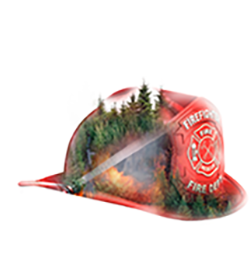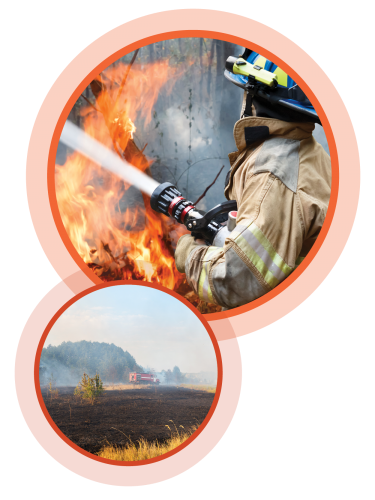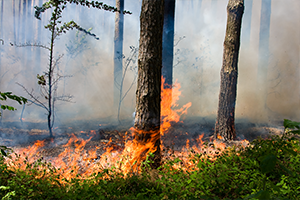 Key Concepts: Fire is a disturbance that can be both natural and human-caused, including some fires that are introduced by humans as a management tool. [PLT Forest Literacy Framework, Concept 1.C.6]
Key Concepts: Fire is a disturbance that can be both natural and human-caused, including some fires that are introduced by humans as a management tool. [PLT Forest Literacy Framework, Concept 1.C.6]
Objectives: Provide opportunities and materials for learners to:
- Explain how different fuels affect the potential for wildfire within a particular forest.
- Describe ways to reduce the fire risk to homes in the wildland–urban interface.
Session Time: 50 minutes
Setting: Outdoors
 From an ecological standpoint, fire is neither “good” nor “bad.” Fire is a natural event in many forest ecosystems and can help to recycle nutrients back into the soil or help some plants regenerate. It is also important in the life cycle of several tree species that need intense heat to open their cones.
From an ecological standpoint, fire is neither “good” nor “bad.” Fire is a natural event in many forest ecosystems and can help to recycle nutrients back into the soil or help some plants regenerate. It is also important in the life cycle of several tree species that need intense heat to open their cones.
Fires must have heat, fuel, and oxygen to burn; these three elements are known as the “fire triangle.” Initially, the heat is provided by an ignition source such as lightning, matches, or sparks. Fuels include dry trees, dead trees and limbs, leaf litter, and dry grass. Oxygen is available in the air. Without enough of one or more elements of the fire triangle, fire will not burn.
As more homes and other buildings are constructed near forests and wildland areas, people and property are increasingly threatened by wildfire. Preventing, controlling, and suppressing fires in this wildland–urban interface is a challenge. A prescribed burn (one that is lighted and managed by trained fire personnel) can reduce burnable fuels and reduce future fire hazard, while also enhancing natural habitats. By promoting healthy forests, forest managers help to reduce the risk of wildland fire and prevent unwanted effects of fire.
Materials:
Five metal containers or pans, different-sized fuels, fire extinguisher, buckets or other containers filled with water, safety goggles, paper, and drawing materials.
Get Ready:
Set up five metal containers and fill each one halfway with the following fuels:
- Different-sized live branches, leaves, and needles (all green).
- Different-sized dead and dry branches, leaves, and needles.
- Different-sized dead and damp branches, leaves, and needles (or a dry assortment that has been sprayed lightly with water).
- Large-diameter fuels, such as branches or whole pieces of wood (not kindling).
- Partially burned pieces, such as from a fireplace or campfire (used but not completely consumed).
Identify a site for learners to assess using the Worksheet.
 Introduce
Introduce
Point out that as city populations expand, the urban boundary expands into wildland areas. This means that more and more people are building homes in woodland and grassland areas. Ask:
- What might be the risks in living next to or within wildland areas?
- How might people reduce the risk of fire in these wildland–urban interfaces?
- How might the type of fuel around the homes affect the fire risk?
Experience
- Show student the five different containers you have prepared, describing the contents of each. Tell them that you will try to start a fire in each container. Have students predict which fire will be easiest to start, and which will be most difficult.
- Use matches to try to light a fire in each container, one at a time.
Safety Check! Place metal containers outside on a fire-resistant surface (concrete, asphalt, or bare earth) away from cars, buildings, and dry vegetation. Be sure to have water and a fire extinguisher readily available. Ask another adult to assist with the demonstration, and wear safety goggles.
- Lead a discussion about the results and the implication for wildland fires:
-
- Which fuel burned the most readily? Which is most difficult to burn?
- What types of plant materials would be best to have around residences in wildland–urban interfaces?
- How do prescribed burns help to reduce the risk of wildfires?
- Provide students with copies of the Wildfire Safety Checklist Worksheet and have them use it to assess the site.
Connect
Introduce the concept of wildfire behavior, discussing how an area’s slope, fuel density and weather can affect fire conditions. Take students on a walk through your site or nearby area to identify elements of the fire triangle that could affect wildfire behavior or intensity.
How do healthy forests depend on wildland fires? How do they help to prevent high-intensity wildland fires that are particularly damaging in wildland–urban interfaces?
TAKE ACTION!
Invite student students to design a home that is safer from wildfire, using art materials to draw a picture or make a model. Remind them to include conditions around the home that could affect wildfire safety. Encourage them to share their designs at a later time, pointing out the safety features.


 Key Concepts: Fire is a disturbance that can be both natural and human-caused, including some fires that are introduced by humans as a management tool. [PLT Forest Literacy Framework, Concept 1.C.6]
Key Concepts: Fire is a disturbance that can be both natural and human-caused, including some fires that are introduced by humans as a management tool. [PLT Forest Literacy Framework, Concept 1.C.6] From an ecological standpoint, fire is neither “good” nor “bad.” Fire is a natural event in many forest ecosystems and can help to recycle nutrients back into the soil or help some plants regenerate. It is also important in the life cycle of several tree species that need intense heat to open their cones.
From an ecological standpoint, fire is neither “good” nor “bad.” Fire is a natural event in many forest ecosystems and can help to recycle nutrients back into the soil or help some plants regenerate. It is also important in the life cycle of several tree species that need intense heat to open their cones.  Introduce
Introduce